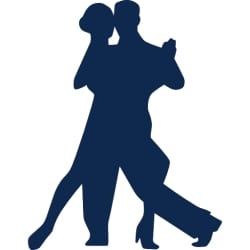Learning tango can be daunting and confusing. But it doesn’t have to be. We asked amazing tango professionals to tell us what they would do differently if they were starting tango today. The result?
An easy guide to learning Tango – 6 elements

Stay with us, and you will be able to avoid lots of frustration and get to the fun stuff faster. But don’t overthink it. The important is that you start learning tango.
Here is what we will discuss:
- Understand why you want to dance tango
- How to choose the right tango teachers for you
- Understand the learning process
- Bring yourself into your tango
- Learn how to break through
- Shoes and Clothes
Just go! Go dance, embrace and enjoy. – Patrick Remmerswaal
Understand why you want to dance tango.
People come for different reasons to tango. Knowing the reasons you want to learn tango can help you make the right choices for you.
You might decide to learn tango to:
- let go of the stress of the day and empty your mind,
- socialize, talk, laugh,
- be hugged,
- find the love of your life,
- experience passion,
- stay active,
- make new friends,
- perform in front of your family or 2000 people,
- forget your problems for a while, etc.
No matter what your main reason is, knowing it will help you decide how you want to proceed with learning tango, how you want to practice, which teacher is the right one for you, and much more.
Your reasons will drive you forward
People want to go away from pain and move toward pleasure. Knowing with clarity what you are moving away from and what you want to get will help you overcome challenges on the way.
Your Tango development relates to your personal development. Allow yourself to bring your personality into the dance. And always dare to try something new. All good dancers have had many teachers. – Sayaka Higuchi & Joscha Engel
Your reasons will define what you want to learn
Even if you were learning tango for 40 years you would still have a long way to go till you say you know everything – if there is even such a thing as “knowing everything”.
Knowing why you dance tango, will help you discover what is the right thing for you to learn. If what you want is to be hugged for example, learning how to do complicated steps or jumps might not be something you need to do. You can focus on improving the quality of your embrace.
If you are not certain yet why you are interested in learning tango, you might want to read the blogpost “The three reasons we dance tango”.
Stop rushing through the levels and enjoy the journey. The truth is that only when you realize that Tango is a never-ending journey towards the horizon, not some kind of ladder that you need to climb, will your body open for feelings and sensation. And only then – you will find the Tango. Anita Flejter
How to choose the right tango teachers for you
Great, you found your why. Now the time has come to find your teacher.
How do you decide?
It’s not easy to make decisions when you don’t know much about something.
Tango newsletters like this and tango books like this can be helpful.
Other than that, here are some thoughts to help you:
The fit is what matters the most
You can learn something from everyone you talk to. BUT… there are some teachers that might be the wrong teachers for you and the right teachers for someone else. The most important is to find the teachers with which you fit the best.
Some criteria to keep in mind:
- The right teacher should be teaching you based on YOUR why.
- A great performer is not always a great teacher.
- You might be learning tango easier by listening, seeing, or feeling. The right teacher should be able to teach in the way you understand the best.
Try different schools to find the teachers that are good for you. – Latifè y Matthis Tango
There are different types of tango teachers
Starting from biomechanics or tango?
There are tango teachers that help you understand how your body works and then bring these realizations to your tango. Other teachers start from teaching you tango steps and helping you understand your body through them.
It’s up to you to decide what you prefer.
Note: there are some tango teachers that will teach you tango though tango stories too 🙂
After going to different classes I would narrow it down based on four criteria: is what we are doing in class painful, does the teacher do what he/she preaches, what’s the teachers attitude before/during/after the class, and do I see the teacher in the milongas. – Chrisa Assis
Accepting to be wrong
There are teachers that will never admit not knowing something or that they don’t know how to explain something to you. Those teachers often are quite strict on defining one “correct” way of doing things and defining everything else as wrong or ignorant.
On my personal learning journey, I found out that I learned a lot more from teachers who admitted that they were not certain how to explain something and that they were willing to discover the appropriate answers together with me.
Willing to explain and answer “Why?”
Choose a teacher that doesn’t tell you what to do, but why. The “why” is better than the “must”. – Paula Barceló and Enrique Gianetti
Not all teachers are good at explaining why something works a certain way. Some hide their lack of knowledge by giving answers like “Because this way you are more stable,” or “Because this is how your partner can understand you better”. Although these might look like answers, they don’t actually explain why something works.
When you are looking for a teacher, make sure to ask “Why?” a few times during a class and see how they respond.
Download the free TangoPartner App now to discover nearby tango teachers and social dancers.
Willing to serve
Plain and simple:
Do your teachers believe that they are here to help you to the best of their abilities, or do they believe that you should idolize them?
Finding teachers that are willing to put their ego on the side and focus on finding the right way to connect with you, and even adjust their teaching practices to help you learn, is not always easy.
But when you find a teacher like that, your learning process will instantly improve.
Look for a good teacher with great empathy and sensibility. – Andrea Dedó
Explore different options
Don’t be afraid to try a few classes with different teachers when learning tango. Sometimes, you’ll notice that you enjoy a class a lot more or that you learn a lot faster with a certain teacher, without even knowing why.
A few ways to expose yourself to different opinions about tango:
- Stay away from teachers who talk bad about other teachers and teaching methods. True teachers focus on helping you grow the best way they can, and forget all the rest.
- Use the Tango Partner app to discover teachers closeby whenever you travel. You can use the app to also find teachers that are in your city for just a day or two. Contact them and have a class.
- Read tango books by different teachers, or tango advice collections such as the Tango Tips by the Maestros.
- Join the Curious Tanguero tango newsletter.
- Listen to tango podcasts.
- Try some online tango courses or classes.
If I were a beginner, I would look for an inspirational teacher, someone that could help me love Tango and want to stay in it no matter what, someone that would help me see it’s much more than steps. – Andrea Martinez

Understand the learning process
When you understand your own learning process, you will be able to enjoy it a lot more.
Let’s see some ways to do that.
All the structures that one learns aren’t fixed rules. Tango is totally free. Teaching specific tango sequences is like teaching vocabulary or grammar. It seems to be one of the most successful ways to teach and to learn. But, one always needs to be conscious that these combinations are only suggestions and inspirations to create your own dance. – Roberto Herrera
Let it sink
Don’t force learning tango. Give it time. Lots of things need to happen till a new step or change can be incorporated in your dance. Your brain might need to understand it better, your body might need time to feel comfortable with it, muscle memory might need to be developed, and much more. Sometimes, even your mind or your emotional state might block you.
So, don’t force it. Let it sink. Sometimes, the same step that you couldn’t do in the previous class even if you had a gun at your head, somehow, becomes easy a few days later.
Focus on enjoying the learning process, and let go.
If I were a beginner today, I would focus on the music, walking and connecting with my dance partner. Mata Djoreva
Be aware of your and other people’s feelings
Once, after 11 years of dancing tango, I had a teacher pointing at my feet almost screaming “Where is the ocho? Where is the ocho?” The ocho is one of the simplest steps in tango, that students usually learn in their first or second class.
I felt stressed. I also felt that the teacher was not looking for my answer, but for the answer that she wanted to listen. I realized in her mind there was only one correct answer, only one adequate description and everything else that came out of my mouth would be (and was) wrong.
That’s not what I consider a good learning environment. I was lucky, because I was able to understand my feelings, and instead of internalizing the stress, I simply thought: “OK, how can I help her feel better?”. I continued the conversation in a non defensive way, allowing her to feel better about being right.
Being aware of my feelings allowed me to make a clear decision: this teacher is not for me. Focusing on the feelings of the other person, I was able to show empathy instead of defensiveness. This created a better environment. Be aware of your feelings.
Your Tango journey will always develop with your personality. A good Tango teacher will see where you are at and what fits for you in the moment. A good indicator is your personal feeling when a teacher gives you feedback. Try different teachers and stick to where you feel comfortable, seen and valued as a person. Don’t hesitate to move on. Good dancers have had many teachers. – Sayaka Higuchi & Joscha Engel
Understand what you don’t understand.
Most students don’t take ownership of their learning journey, and they just surrender to the intuition and skills of their teachers. Although finding a great teacher is invaluable, as a student you can create a better learning journey if you reconsider how you approach learning tango.
A key way to do it is to realize that there are at least three possible combinations when it comes to understanding something your teacher explained or something that your are trying to do:
- You understand.
- You understand what it is that you don’t understand.
- You don’t understand what it is that you don’t understand.
Knowing the difference between the second and third possibility is crucial. Every time you feel confused, try to figure out if you are in the second or third scenario. And share it with your teacher.
Explain your expectations
Your teachers are humans who make mistakes and assumptions. Take a moment to explain to your teachers your expectations of the class and of your learning journey.
For example:
- I want to develop my skills as fast as possible till I am the best leader/follower in the class.
- I would love it if you don’t just show the new steps, but if you can also dance with me so that I can feel them.
- I want to enjoy the class, laugh and socialize. If I am a bit better at the end of the class, I will be happy.
- I want more time to practice each new sequence before you give me the first corrections. My body needs more time for focused repetition.
- I enjoy when you explain the biomechanics of each movement and exactly how a modification in the way dance will change other parts of my dance.
All those are clearly stated expectations. Your teachers can choose to take them into account or not, but at least they don’t need to guess or assume.
Anything that a teacher says, is his/her personal opinion. It’s not a fixed rule that is valid everywhere and for everybody. Another teacher might teach it differently, but that doesn’t mean one of them is wrong. The opposite: both can be right. Take every single piece of information that you can get from as many teachers as possible. Accept the suggestions and try them. When you learn to use them, pick out the concepts, techniques and styles that serve you personally. – Ani Andreani de Herrera
Remove the noise
Imagine trying to learn to play the piano while someone is watching an action film behind you. It’s hard, there is too much noise. You got to remove the noise so that you can learn easier.
It’s the same with your practicing tango. Anything else that you need to do beyond the part that you are actually trying to learn is “noise”.
If you can eliminate the unnecessary elements then you can focus on the one thing that you want to learn. Once this is clear, you can start adding new elements.
Tango is a social dance of encounter. Without looking for it it becomes a body therapy that supports and accompanies you and gives joy to the heart. -Viviana Laguzzi
An example or removing noise while practicing tango
If you want to improve your embrace, some teachers might ask you to simply walk while embracing your partner. This eliminates the “noise” that a complicated sequence would create.
Can you have less noise? Yes! Don’t even walk. Embrace and dance a song just with subtle changes in the way you hug. This removes the “noise” of walking. Once you try that, then you can add walking and see if you can maintain a good embrace. Then you can add more noise.
A pinch of salt
A pinch of salt usually makes food taste better. My advice to you, take each advice someone gives you with a pinch of salt. (Yeap, I see it.)
Questioning each advice can help you understand your tango better. If you want to explore this deeper, I would recommend reading “How to answer tango questions easier – a simple tool”
Musicality level vs technique level vs adjustment level vs empathy level vs…
Often tango dancers will tell you they are beginners, intermediate, or advanced. Although this can be a helpful yet limited categorization, it is important to understand that there are many “levels” in tango.
For example, imagine you are a dancer that has an impeccable technique but cannot choose the right steps to fit the music. You are an advanced dancer when it comes to your technique, and a beginner when it comes to musicality.
Or, imagine you are a dancer that can do incredible steps when dancing with one partner, but cannot do almost any step with any other dancers. That means you might be a beginner when it comes to understanding how to adjust your embrace.
Or imagine that you can lead any step you want, adjust your embrace to every partner, and transform each musical note into a step, but you can’t understand the emotional condition your partner is in. How can you create a meaningful dance if you can’t understand what your partner needs?
Once you understand there are different aspects of your dance, you can do a better evaluation of your current state. Most importantly, you might find out that improving just a bit toward one direction can improve your overall dance quality a lot faster.

To get unstuck when learning tango seek to add to your learning different styles till you find your own and to this add musicality classes. – Viviana Laguzzi
Dance, dance, dance
In tango you have plenty of opportunities to dance. Take advantage of them. Some people say that “Tango is kilometers”, meaning that dancing can help you internalize what you are trying to learn.
Where can you dance?
- Classes
That’s where you can ask your teacher, dance with different partners, and improve your dance.
- Praticas
That’s where you can practice in a free format for hours whatever you choose. Simple go the pratica with a partner and practice exactly what you want to practice. In some praticas, teachers are also there to help you.

Milongas are usually not the right place to practice a step that you want to learn. But they are perfect places to dance using your existing dancing vocabulary, and also to watch other people’s dance.
Spending two or more days in an immersive tango experience is a wonderful way to explore your tango. Often, you’ll get to dance with people from all around the world who dance differently than you. This gives you the opportunity to explore and identify different ways of dancing and connecting.
- Finally, for more opportunities to dance, you can simply download the Tango Partner app, and connect with nearby tango dancers and teachers, find events, and even online offers.
Tango is like life on the dance floor and life is like tango off the dance floor. – Harvey Schwartz

Bring yourself into your tango
Tango is here to help you express who you are. Often though, people tend to define themselves in tango based on their level. Don’t fall in that trap.
I have danced with CEOs and very successful entrepreneurs whose day-to-day responsibilities demand a strong character and proactive attitude. Yet, when they danced tango, suddenly they shrank into non decisive beings just because they felt they were “beginners”.
No matter your level, you are still a human with needs, qualifications, character, values. Don’t forget them. Allow them to define your tango, instead of allowing your tango level to define your behaviour.
Bring yourself into your tango.
Tango is a pathless land. – Diego Bado
Learn how to break through
Whenever you learn a new skill you are bound to get stuck at some point. Knowing how to break through can help you.
There are a few ways for you to do that:
Overcorrect
When you recognize there is something you keep doing wrong and want to change it, you might want to use overcorrection.
If you keep falling toward one side, try to start falling toward the opposite side. If you keep stepping with your feet a bit forward when you try to do a side step, try to step a bit backwards. If you keep leaning forward, try to lean a bit backward. Obviously, always make sure that what you are doing is safe, and in case of doubt as a trained professional.
Learning tango comes in waves. You may feel you are learning nothing, and one day – it can be tomorrow – everything falls in place, and you experience your tango epiphany. That exhilaration carries you on, and you will climb the mountain of progress, and then you will get stuck again. You can choose to just dance through it (your ‘stuckness’ is often un-perceivable to your partners) or stop dancing for a week or two. Weirdly enough, it passes. For us – those waves signify remarkable progress. We are actually happy when we see you are getting close to the ‘stuck’ point. – Anita Flejter
Understand what bothers you and ask your teacher
If something feels uncomfortable or weird, ask your teacher.
For example, for years I heard that I need to keep my core engaged. I took that to mean that I needed to activate my abs. On the other hand, my teachers always told me that I should not hold my breath. It should be easy to breathe.

The thing is, the diaphragm and the abdominals form what is known as an antagonistic pair of muscles. When one contacts, the other relaxes. When you breathe in, or inhale, your diaphragm contracts and moves downward. This increases the space in your chest cavity, and your lungs expand into it. In simple words: additional space is created so you can breathe easily.
Do you see the problem?
When you contract the abs, the diaphragm cannot perform well this function, and the result is simple: your breathing is blocked.
When I found the right teacher that was able to clarify this doubt, I could finally breathe normally. I stopped creating unnecessary muscle engagement and tension. Ask.your.teacher.
Take a pause and try to combine tango with a different discipline that could help me improve my corporal and mental skills like stretching, pilates, yoga, contact improvisation, meditation, etc. – Paula Barceló and Enrique Gianetti
Let it go
Sometimes it is just not the right time. If you start feeling frustrated, failing repeatedly to do a new step or sequence, you might simply need to let go. The time might not be right. There is no reason to force it. You can always revisit it one month later, and see what happens.
If you feel stuck, take a break from what you were doing. Then do different movement practices. Then take a private class with a good teacher telling exactly that: “I am stuck.” – Chrisa Assis
Group classes vs private classes
Group classes allow you to practice in imperfect conditions and learn to adapt. You dance with other students who also have flaws in their dancing skills, and you have to find a way to make it work. If you are a person who learns really fast, you have to learn to follow the slower rhythm of the class. If you learn slower than others, you might need to get a bit outside your comfort zone.
All this helps you learn how to dance when conditions are imperfect.
Find a school where you will switch partners several times during each lesson. It is the best way to learn Tango and avoid getting used to your partner’s mistakes. – Doro Baun
Private classes allow you to practice in almost perfect conditions so that your mistakes are easier identified. Moreover your teacher can fine tune the rhythm so that you can learn exactly as fast or slow as you prefer. You can ask easier questions about problems that only you face, and receive personalized answers. Sometimes, a single private class can fix problems that you couldn’t solve for years.
Try both options and find a combination of private and group classes that work for you.
Go to a lot of group classes during a few months, and then 1 private class every week or every 2 weeks. And – of course – A LOT of milongas. – Sylvain Mastrogiovanni
Take advantage of other people’s wisdom and experience
Teachers are not the only ones who can help you in your tango journey. If you see social dancers that you really like, start a conversation. Ask them how they learn, how they practice, how they understand tango. Take advantage of their experience.
A while ago I mentioned tango books as an efficient and enjoyable way to dive deeper into years of experience and realizations. Use them to learn.
I would look for information different from what I already have. I might dance with people other than whom I usually dance with, go to group classes if I only take privates or any routine breaker one might think of. Feeling stuck means one has tried and pushed in the same direction for a while, so taking a step in a different direction is undoubtedly helpful to change the perspective. It doesn’t mean I won’t go back to the teacher or situation I was used to. If I do, I’ll be able to see it with new eyes. – Andrea Martinez
Shoes and Clothes
Tango shoes and clothes come in many different forms. Once more it is important that you bring yourself into your tango, and not the other way around.
Feeling comfortable in what you wear can have an impact on how you are learning tango. I never felt comfortable practicing in tight jeans, so I chose comfortable tango pants. But some of the world’s best dancers dance in tight jeans.
But, beyond the stylistic choices, you might want to ask yourself more “functional” questions:
- Do these shoes allow me to move freely?
- Do these clothes allow me to move as I want?
- Do these shoes feel stable?
I know people who ask “Does this make people notice me easier in a milonga?”, believing that the more people notice them the more they’ll dance. Others ask “Do these shoes make my embellishments easier to notice?”
It all goes back to “Why you dance”. If you are clear on your why, then you’ll find the right questions for you.
Everything will be alright – Travel and dance everywhere. – Patrick Remmerswaal

I hope this helped you clarify some doubts. But if it is too much, don’t over think it. Just go to a class and dance. Most of the things I mentioned above I wasn’t aware of even after 10 years of dancing. I still enjoyed each part of my tango journey.
This guide was created by Dimitris Bronowski, with the help of our partners Andrea Dedó, Andrea Martinez, Ani Andreani de Herrera, Anita Flejter, Chrisa Assis, Diego Bado, Doro Baun, Harvey Schwartz, Latifè y Matthis Tango, Mata Djoreva, Patrick Remmerswaal, Paula Barceló and Enrique Gianetti, Roberto Herrera, Sayaka Higuchi & Joscha Engel, Sylvain Mastrogiovanni and Viviana Laguzzi. A huge thank you to all for sharing your thoughts and ideas!!!





























